
Landmark hydrogen superyacht linked to Bill Gates hits the water
Feadship’s Project 821 has emerged from its build shed in Amsterdam. The new 119-metre superyacht, designed by British studio RWD, is the world’s first hydrogen fuel-cell superyacht.
Rumours have been swirling for several years that Bill Gates could have commissioned the yacht. In 2020, global media, including the Telegraph, reported Gates had commissioned a £500m hydrogen-powered Feadship superyacht concept, Aqua, designed by Sinot. While Sinot later denied these claims, online reports have consistently linked Gates to Feadship’s Project 821 since the build began.
Whoever the owner initially was, however, they have changed their mind: the new yacht is currently being offered for sale by Edmiston.
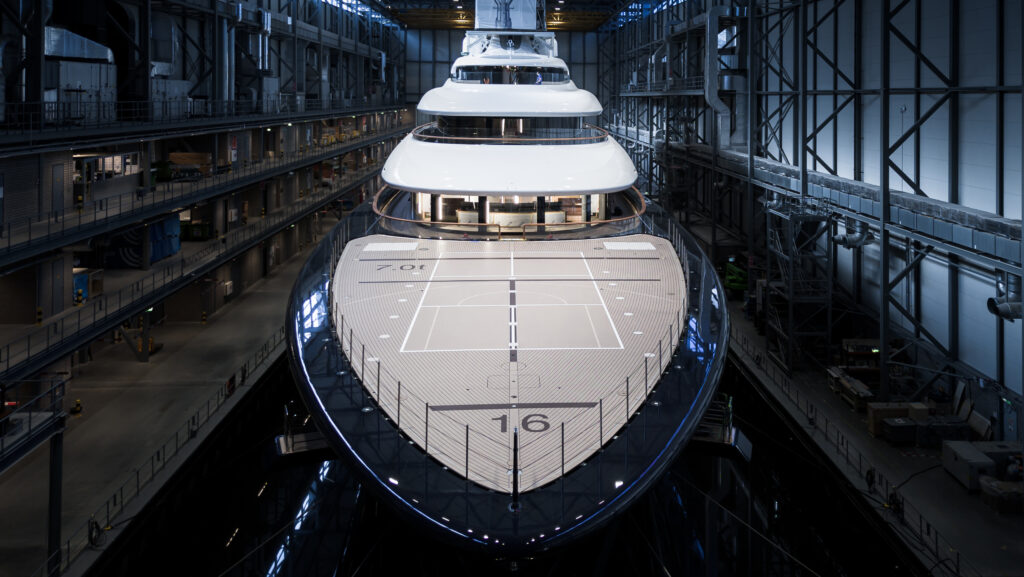
Feadship says the yacht is based on a ‘zero-diesel approach’ designed to cruise between harbours or anchorages and operate its hotel load and amenities with power from green hydrogen.
Hydrogen fuel cells, a combustion-free way to generate electricity, emit pure water as their only exhaust. Feadship’s R&D team has been researching hydrogen, among other fossil-free fuel options, as part of the company’s pledge to develop “net zero” yachts by 2030.
“The aim has been to develop a new, clean technology not just for this project, but for the world,” says Jan-Bart Verkuyl, Feadship director and CEO of Royal Van Lent Shipyard.
Although hydrogen fuel cell-powered cars exist and have been used as the primary source of electrical power in human spaceflight for more than six decades, little exists in the maritime sector. There are no regulations for hydrogen storage and fuel cell systems at the class, flag-state, or even IMO level. Seeking expert partners from allied industries, Feadship, Edmiston, and Lloyd’s Register simultaneously developed equipment, protocols and safety regulations.
“The value of the research, as well as the development of class and flag safety regulations for an entirely new type of energy generation, is an advancement we are proud to have made available to all,” Verkuyl says. Next year, for example, two long-route Norwegian passenger and car ferries will enter service utilising the system pioneered by PowerCell Group for Project 821.
Feadship found one of the biggest hurdles was developing a reasonable way to store compressed liquid hydrogen below deck at -253°C aboard a luxury yacht.
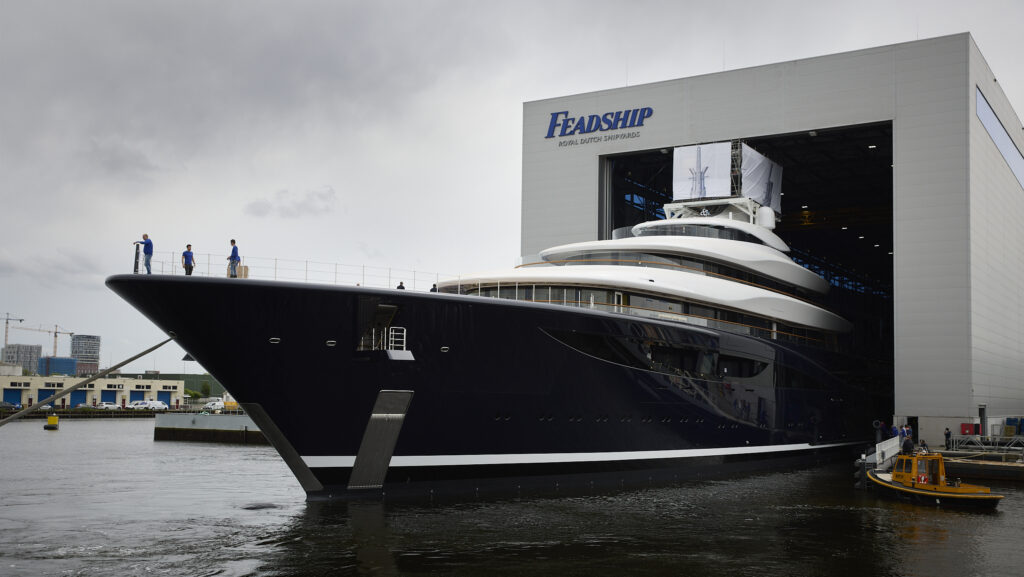
Hydrogen is light – one cubic metre of liquid hydrogen weighs 70kg vs. 800kg per cubic metre of non-fossil diesel equivalent fuel (HVO or e-diesel). However, safely storing it on a vessel requires a double-walled cryogenic storage tank (a large, very well-insulated cooling box in a dedicated room). Together, it takes eight to ten times more space to store hydrogen than the energy equivalent of diesel fuel.
In total, the cryogenic fuel tank that holds 92 m2 (around 4 tonnes) of hydrogen on Project 821, the sixteen compact fuel cells, their switchboard connection to the DC electrical grid, and the vent stacks for the escaping water vapour added four metres to the yacht’s original specification length. Importantly, the fuel cells developed for Project 821 can also use easier-to-store methanol, a liquid fuel in ambient conditions. Steam reforms methanol into hydrogen before the electrochemical reaction in the fuel cell.
Even a yacht the size of Project 821 cannot carry enough liquid hydrogen to power a crossing, but Feadship chose to impact a yacht’s carbon footprint where it is largest — generating electricity to serve the hotel load. According to the Yacht Environmental Transparency Index (YETI), 70-78 per cent of a yacht’s total energy use per year is to supply its hotel load, with heating and air conditioning making the greatest demands.
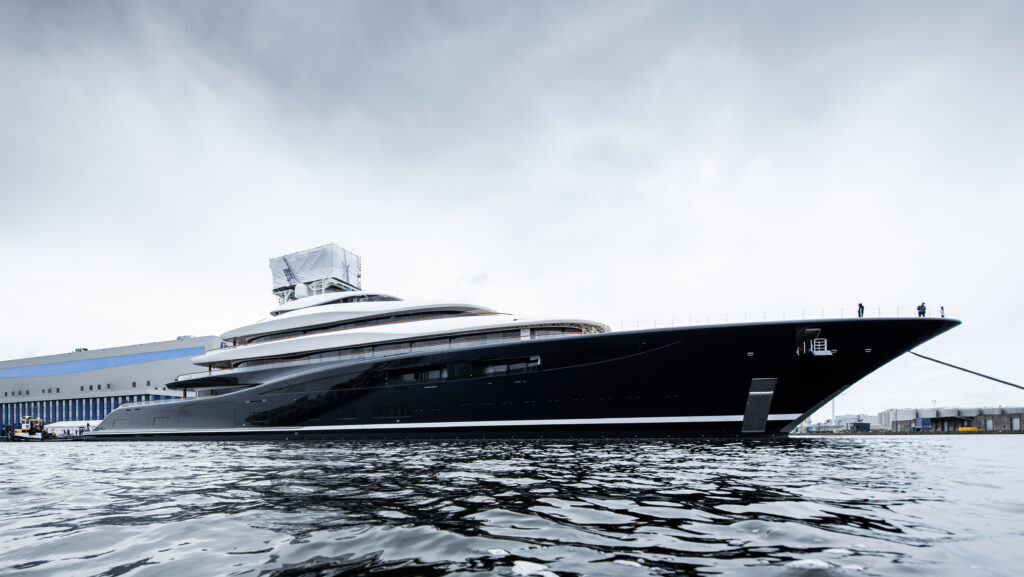
For longer travels or when pure hydrogen is unavailable, the electricity powering the 3,200 kW ABB pod drives comes from MTU generators combusting HVO. This second-generation biofuel reduces harmful emissions by 90 per cent. The validity of powering the yacht’s generators with HVO was tested and proven on the 2023 Feadship Obsidian.
While large battery banks are becoming an accepted way to provide enough power to operate generator-free for silent nights at anchor or to cruise sensitive no-discharge marine preserve zones, Project 821 stores a mere 543 kW hours of energy – compared that to Feadship’s first diesel-electric hybrid, the 83.5-metre Savannah launched in 2015, which stored a megawatt of electrical energy.
But, Feadship highlights, the fuel cell technology on Project 821 can provide an entire week’s worth of silent operation at anchor or navigating emission-free at 10 knots while leaving harbours or cruising in protected marine zones.
Project 821 also features a waste heat recovery system, which heats everything from the pool, Jacuzzi and steam room to the ambient air temperature and towel bars and floors in the guest bathrooms. Further savings in the hotel load will come from a Smart AC system linking sensors to an energy management system that automatically reduces air conditioning or heating in unoccupied guest spaces.
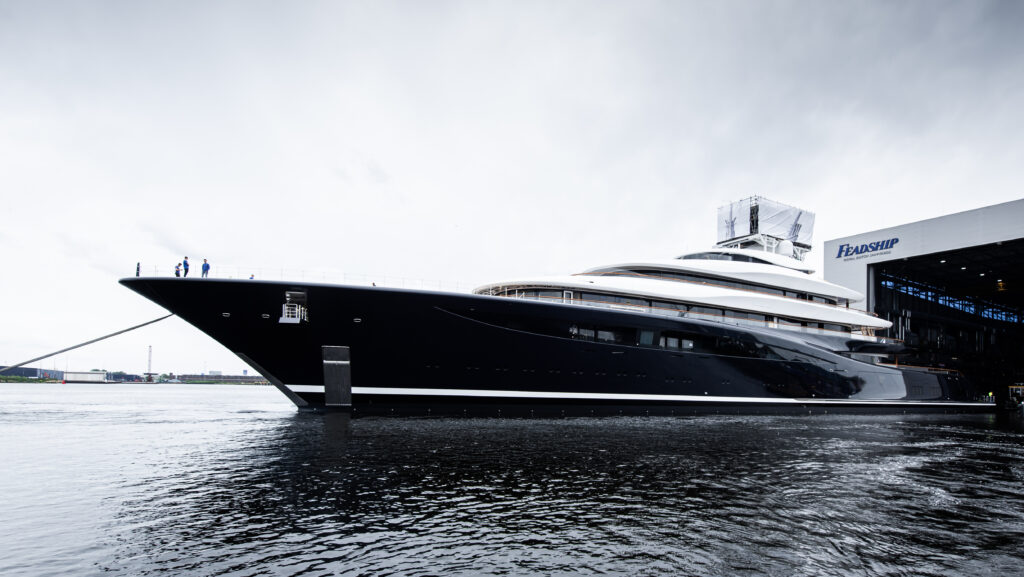
Largest motor yacht launched in the Netherlands
Project 821 is the largest motor yacht ever launched in the Netherlands, just edging out the recently delivered 118.00-metre Launchpad. Despite the fact the two yachts have nearly identical LOAs, Project 821 has 30 per cent more volume.
With five decks above the waterline and two below and even with her sleek mast yet to be attached, Project 821’s height is commanding – the owners’ deck, for example, is 37 metres above the water. It also has the most hull openings of any Feadship to date, including fourteen balconies that slide out from the ‘tweendeck’ space, five large shell doors, and seven opening platforms.
Project 821 is designed for family use. The full owners’ deck above the bridge is essentially an apartment with two bedrooms, twin bathrooms and dressing rooms, a gym, a pantry, and two offices, each with a fireplace and a living room.
The hefty 19-metre beam allows wide corridors inside and side decks outside where guests can walk side-by-side.
The owner’s accommodation extends beyond a single deck. A private vertical corridor extends to the lower deck. This includes both a staircase lined with bookshelves and display nooks and an owners’ elevator.
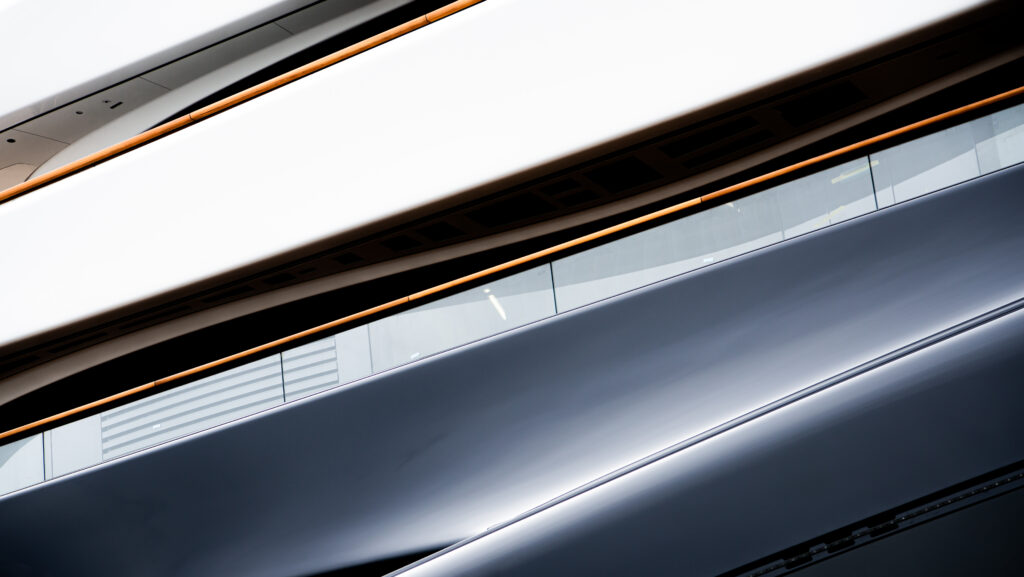
Britain’s RWD Studio created Project 821’s exterior, GA and interior decor. The designers used a pallet of light neutral colours in textured fabrics and leathers, marble, rattan, fumed and taupe eucalyptus, and limed oak to create a luxe coastal vibe. For overall cohesiveness, details such as door trim features and hallway railings repeat their shapes from deck to deck, but the materials change.
Verkuyl says fuel cells will play an important role for yachts in the future.
“We have now shown that cryogenic storage of liquified hydrogen in the interior of a superyacht is a viable solution. Future innovations in fuel cells and onboard reforming of methanol to hydrogen are on the near horizon. For Feadship, the bottom line is that the decarbonisation of Feadship’s upstream process, such as our extensive use of aluminium produced in a more environmentally sensitive way and the production of net-zero carbon-free fuels or hydrogen carriers, deserves utmost priority.”
Jamie Edmiston, chief executive of Edmiston, adds: “The brief was to build the greenest and most environmentally advanced yacht ever built, without compromise. It was a huge challenge, but one that the team has embraced and delivered on. The yacht we see today, designed by RWD and built by Feadship, is without doubt the best yacht ever built. I am proud to have been involved since the inception of this idea.”
The post Landmark hydrogen superyacht linked to Bill Gates hits the water appeared first on Marine Industry News.
